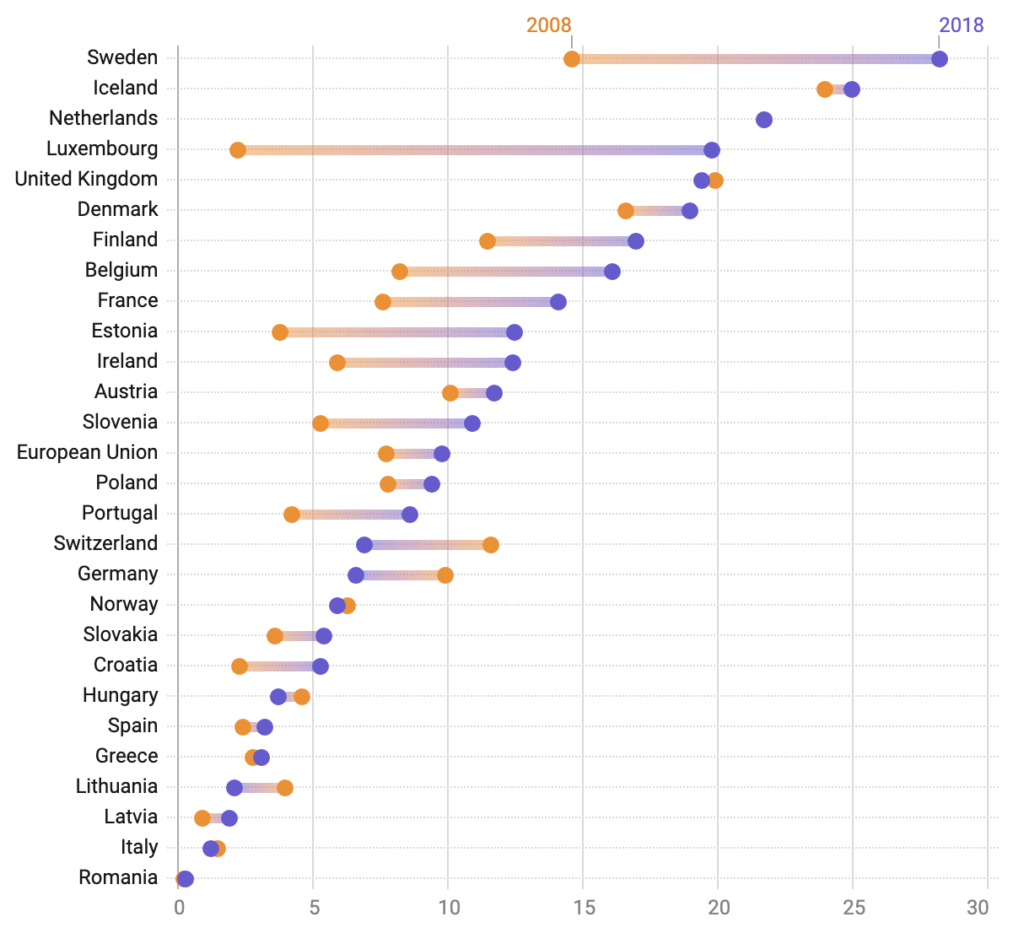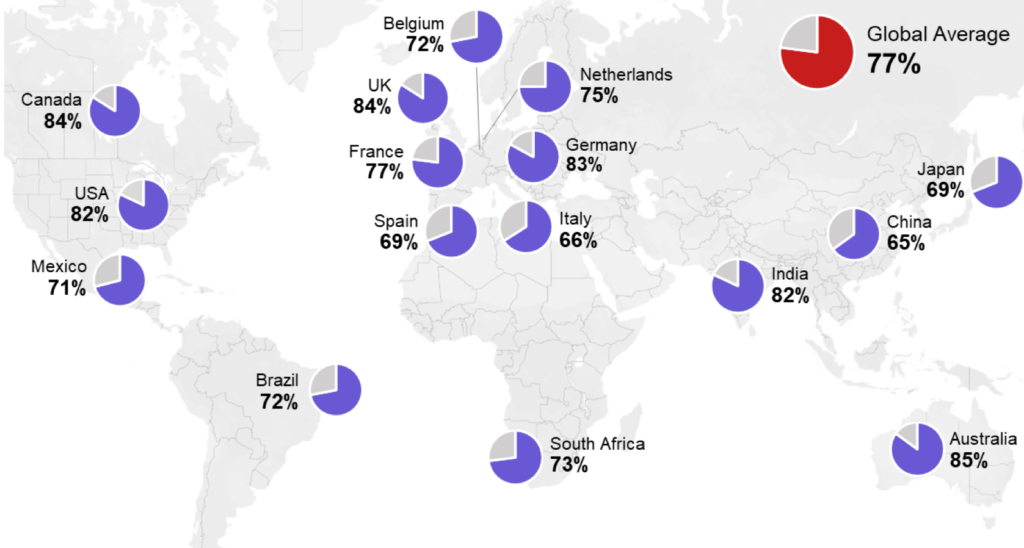We’ve collated the most recent and reliable global remote working data from official government statistics, large independent surveys, census data and academic studies to bring you the definitive guide to the state remote working around the world.
You’ll learn where, why and how many of the global workforce are spending less time in the office and more time working remotely on their own terms.
You’ll see that flexible working arrangements are quickly becoming the new normal across many countries and industries. Across the globe, working from home and remote locations has grown 159% since 2005, more than 11x faster than the rest of the workforce.
Flexible working conditions are not only generating happier, more productive employees; it’s a valuable incentive employers are using to attract new applicants. Many of today’s job seekers are searching for greater work/life balance, and broader choices in terms of where – and how – they work.
Go To Section:
- Prevalence Of Remote Employees By:
- Effect Of Remote Working On:
- Workforce Opinions On The:
- Impact of Remote Working On:
Prevalence of remote working by country
There continues to be a year on year increase in companies offering flexible and remote working
A 2019 survey found 61% of global companies currently allow their staff to have some sort of remote working policy.
Only 32% of Japanese companies have flexible working policies, yet 80% of Japanese employees express the desire to work remotely.
IWG Global Workplace Survey
Date: March 2019
Survey Participants: Over 15,000 business people across 80 nations.
In 2016, 60% of US companies offer their employees telecommuting opportunities which is a huge 3x increase from 1996 to 2016.
Society for Human Resource Management (SHRM) benefits survey
Date: 2016
Sample Size: 600 U.S. employees
% of businesses within each country reporting a flexible workspace policy vs employees who consider flexible working to be the new normal (hover for country figures)
Date: March 2019
Survey Participants: Over 15,000 business people across 80 nations.
European workforce ‘sometimes’ working from home as a % of the total employment (2008-2018)

Notes: The Neatherlands does not have data from 2008 (it only started submitting home working figures in 2014).
US workforce who work remotely…
In some capacity
0%
all of the time
0%
Whilst the figures above are from 2016 and older than our other data sources, they are from Gallup’s huge database of over 31 million respondents and therefore more reliable than the 2019 surveys of a few thousand employees.
Gallup Report State of the American Workplace
Publication Date: 2017
Data will be updated when they release the 4th version (hopefully sometime in 2020).
Data collected from more than 195,600 U.S. employees and more than 31 million respondents through Gallup’s Q12 Client Database.
“A key takeaway from our research is that if a work setting is ripe for remote work – that is, the job is fairly independent and the employee knows how to do their job well – implementing WFA (working from anywhere) can benefit both the company and the employee”
Harvard Business Review
Prevalence of remote working by job position
Across all industries, 18% more executives worked remotely (at least one day per week) than there were working on-site.
The highest proportion of remote workers were amongst the Founders/C-Level Execs (55%) and VP Level (48%).
Remote working is more prevalent amongst senior staff
The typical remote employee is educated, intelligent, and motivated. As people move up the corporate ladder, the likelihood they will work remotely increases with their position.
Effect of remote working on productivity
% of age groups who said they regularly take advantage of anywhere working
0%
Between 45 - 60 Years Old
0%
Between 18 - 34 Years Old
Remote working is more common amongst younger staff
It may be more common for younger employees to work remotely for now, but this paradigm is shifting towards a more even distribution. With retirement ages rising around the world, many people 55 and older are utilising remote work to prolong their careers.
“Employees in their 20s and mid-30s value meaningful experiences more than possessions, and they want to be able to pay attention to all the important aspects of their lives”
Iwo Szapar, CEO Remote-How
Effect of remote working on productivity
of remote employees are more productive overall, and also take fewer breaks and sick days
0
%
Date: March 2013
of over 15,000 global business confirmed that greater location flexibility lead to an increase in productivity
0
%
Date: March 2019
Survey Participants: Over 15,000 business people across 80 nations.
% of business people (right scale) reporting the increase in productivity (left scale) believed to be made by a flexible workspace policy
None
0%
0-10%
0%
11-20%%
0%
21-30%
0%
31-40%
0%
40%+
0%
Date: March 2019
Survey Participants: Over 15,000 business people across 80 nations.
For most people and job types, productivity increases when there is a flexible workplace policy.
Freed from the distractions, noise, and even politics of a busy workplace, the majority of remote workers experience a boost in performance when left to their own devices.
“Businesses must adopt a fluid approach, embracing the ‘Work-as-a-Service’ model, rather than attempting to define when and where people should feel their most productive.”
Fuze
Effect of remote working on staff retention
% of global businesses that are using flexible workspace policies to attract and retain top talent

Date: March 2019
Survey Participants: Over 15,000 business people across 80 nations.
Predicted boost in employee retention in 2020 when companies support a “choose-your-own-work-style” culture
0
%
Gartner Research Note
Date: March 2018
Having a choice of work location is …..?
a key factor for me when evaluating new career opportunities
0%
more important to me than working for a prestigious company
0%
more important to me than having an increase in holiday allowance
0%
more important to me than never working overtime
0%
more important to me than having a more prestigious role
0%
Date: March 2019
Survey Participants: Over 15,000 business people across 80 nations.
Effect of remote working on wellbeing
number of workdays lost (15.4 million days) to workplace stress and anxiety in the UK alone
0
%
Most & least common reasons remote workers gave for deciding to work remotely
Better work-life balance
0%
Improved productivity
0%
Avoid commuting
0%
Less stessful
0%
Saving money
0%
Childcare responsibilities
0%
Accomodating Disability
0%
Moving home
0%
No company office
0%
Eldercare responsibilities
0%
The wellbeing of employees is typically improved when there is a flexible workplace policy
As well as being more productive, remote workers are usually less stressed and have a higher work-life balance. Working from home can reduce workplace anxiety while boosting job satisfaction.
“Workers who have control over their schedules report finding time to exercise more, eat better, and have higher morale and a better outlook in general.”
American Psychological Association
Downsides of remote working
of remote workers want employers to provide better technology that helps them stay connected with their colleagues
0
%
Despite the potential downsides, remote work is generally a net positive.
Whilst there are certainly emotional and technical challenges associated with working in a different location to colleagues, those you do work off-site even just once a month are 24% more likely to feel happy and productive in their jobs.
“We need to acknowledge that isolation, anxiety, and depression are significant problems when working remotely, and we must figure out ways and systems to resolve these complex issues”
Amir Salihefendic, CEO of Doist
Increasing demand for remote working
US Office workers who stated they would leave their job for one that offers flexible work
0
%
Gallup Report State of the American Workplace
Publication Date: 2017
Data collected from more than 195,600 U.S. employees and more than 31 million respondents through Gallup’s Q12 Client Database.
80% of people said that when faced with two similar jobs, they would turn down the position that didn’t offer flexible working conditions
0
%
Date: March 2019
Survey Participants: Over 15,000 business people across 80 nations.
What employees would would give for greater location flexibility
Move to another company
0%
Take on a greater workload
0%
Pay for their own technology
0%
Give up company benefits
0%
Take a pay cut or demotion
0%
Date: 2019
Survey Participants: 6,604 knowledge workers working in companies with 500+ eomployees. The survey was done online and the respondents were based in Australia, Canada, France, Germany, The Netherlands, Scandinavia, Spain, the US, and the UK.
For most people and most companies, productivity increases when there is a flexible workplace policy.
With vast increases in employee productivity and job satisfaction, it’s clear that flexible and remote working arrangements will be a cornerstone of future workplaces.
The standard 9-5 job will become a rarity in the future as flexible working becomes mainstream.
“Leading corporations are recognising that to achieve greater employee responsiveness, they must engage workers more, and discover when, where, and how they work best.”
Sophie Wade, Flexcel Network
Influence of remote working on finances
average annual company savings for each employee allowed to work at home for half the time
$
0
K
Date: 2019
Analysis of 2005-2017 American Community Survey (US Census Bureau)
Key Takeaway
Allowing employees to work off-site is the definition of a win-win situation. Production goes up, costs come down, and people are happier in their jobs.
“Businesses are continuing to embrace at least some form of remote work, likely because they’ve experienced the benefits of greater productivity, less wasted time, and lower overhead firsthand.”
Dave Nevogt, CEO Hubstaff
Influence of remote working on the environment
If those with remote compatible jobs worked at home half the time it could result in saving the following:
54 million tons of greenhouse gas
That is the equivalent to taking 10m cars off the road.
Date: March 2019
Survey Participants: Over 15,000 business people across 80 nations.
119 billion miles of motorway driving
That is the equivalent to taking 10m cars off the road.
650 million barrels of oil
Costing roughly $64 billion.
Date: 2019
Analysis of 2005-2017 American Community Survey (US Census Bureau)
tons of greenhouse gas that could be reduced each year if those with remote compatible jobs worked at home half the time (equivalent to taking 10m cars off the road)
0
million
Date: 2019
Analysis of 2005-2017 American Community Survey (US Census Bureau)
Remote workers are a net positive for the environment.
They use less fuel, consume fewer resources, reduce strain on infrastructure, and lower greenhouse gas emissions overall.
Legals
Copyright © ALL RIGHTS RESERVED 2025
Address: Spaces, 9 Greyfriars Rd, Reading, RG1 1NU
Company Number: 09017066